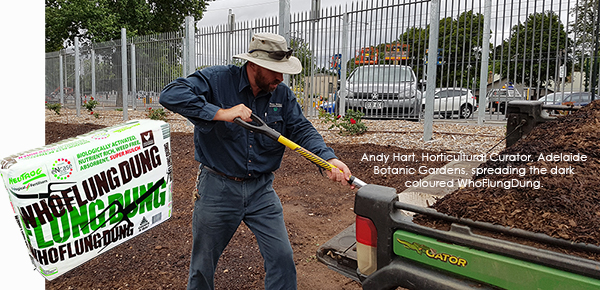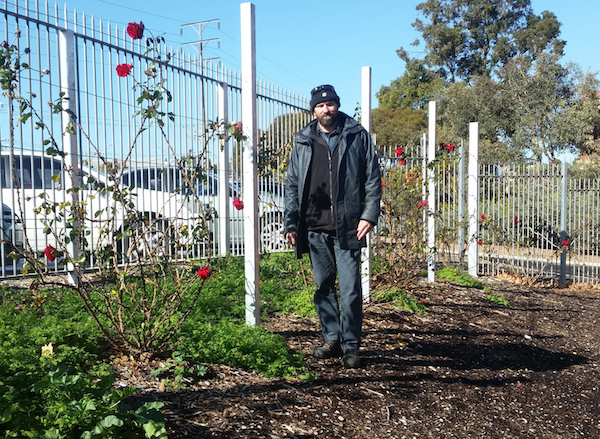
Approximately 500 square metres of the International Rose Trial Garden at the Adelaide Botanic Gardens was covered with Neutrog’s super mulch, Whoflungdung. Microbiologist Dr. Uwe Stroeher worked in close consultation with Adelaide Botanic Gardens’ Horticultural Curator, Andy Hart, to measure and record results. The mulch was applied in December 2017 to a depth of approximately 75mm, right next to pine bark chips (light coloured against the fence pictured above) in order to make an easy comparison. Even after a short amount of time the results were obvious.
International Rose Trial Garden Before Whoflungdung
Before Whoflungdung was applied, the soil lacked significant levels of key nutrients, including nitrogen, potassium and several micronutrients. The original recommendation was to supplement the soil with over 60kg of nitrogen and 30 kgs of phosphate per hectare to create ideal growing conditions.

Adelaide Botanic Gardens’ Horticultural Curator, Andy Hart after the 8 month Rose Garden trial.
Left of Andy: weeds growing over the pine bark chips. Right of Andy: weeds suppressed by WhoFlungDung.
International Rose Trial Garden after Whoflungdung
After the application of Whoflungdung, the addition of nitrogen and phosphate was not required. This is likely due to a combination of the nutrients contained within Whoflungdung and the introduction of additional microbial life into the soil.
Examination of the bacterial and fungal activity of the soil showed a two-fold increase compared to the starting activity, particularly for fungal activity which is not surprising given that Whoflungdung contains significant levels of cellulose. The soil pH was reduced from 8.2 to 7.6, which is a remarkable reduction in soil alkalinity, especially considering that alkaline soils are particularly difficult to modify.
The level of nutrient enhancement was also remarkable, with a four-fold increase in available nitrogen and potassium and a two-fold increase in available phosphorous. There were also significant increases in the levels of zinc, iron, manganese, molybdenum and boron.
Whoflungdung held up well over the trial period. There was some breakdown of the material, but although applied on a slope, the material remained very stable and was not blown around by the wind or washed away by rain. It retained its natural dark brown colour, with no bleaching even after after the hot, dry summer. Andy Hart, the horticultural curator, noted the most remarkable effect was there were virtually no weeds growing on or through the mulch, which meant no weed control was required in this area for over eight months! Other areas that were covered with pine bark chips required frequent spraying and pulling out of weeds.
